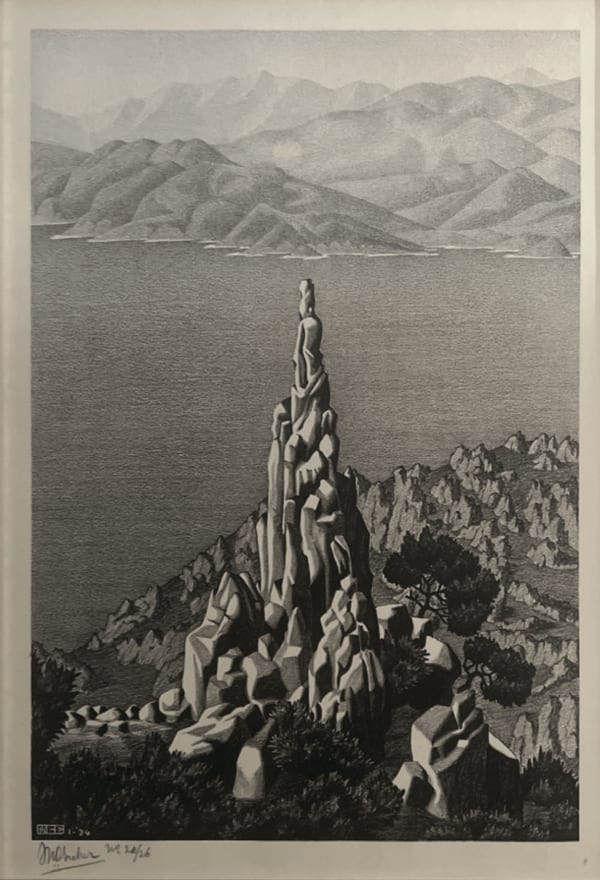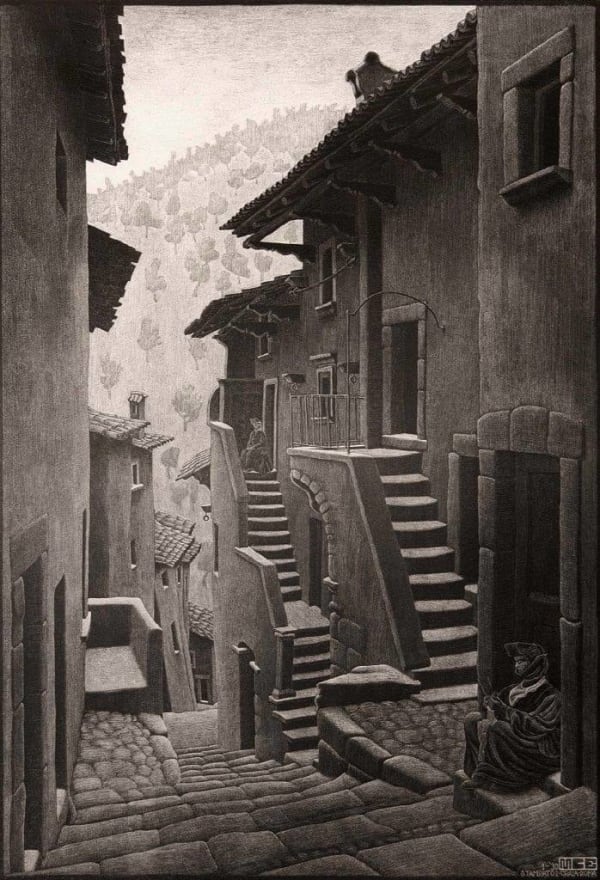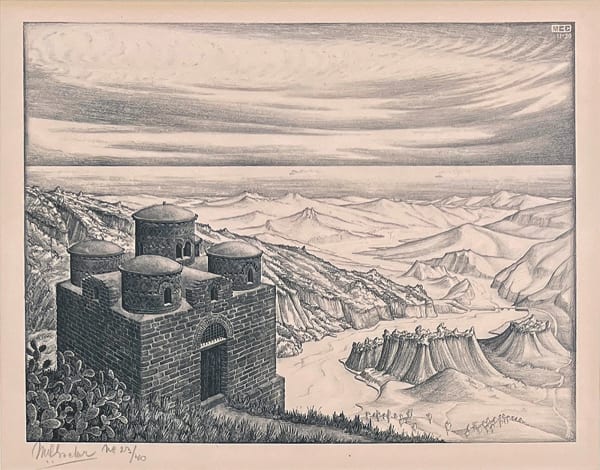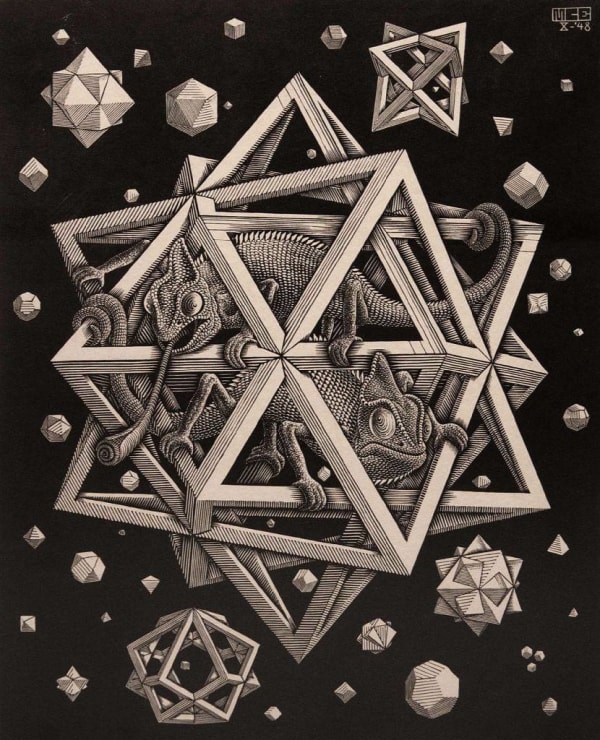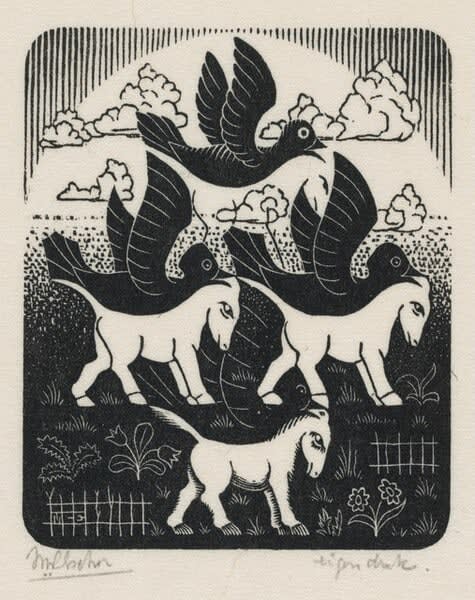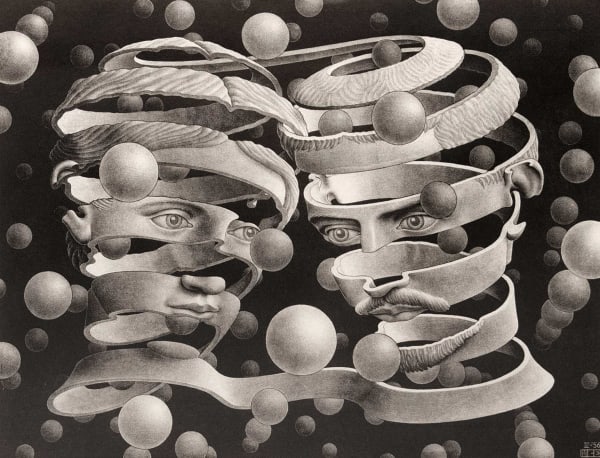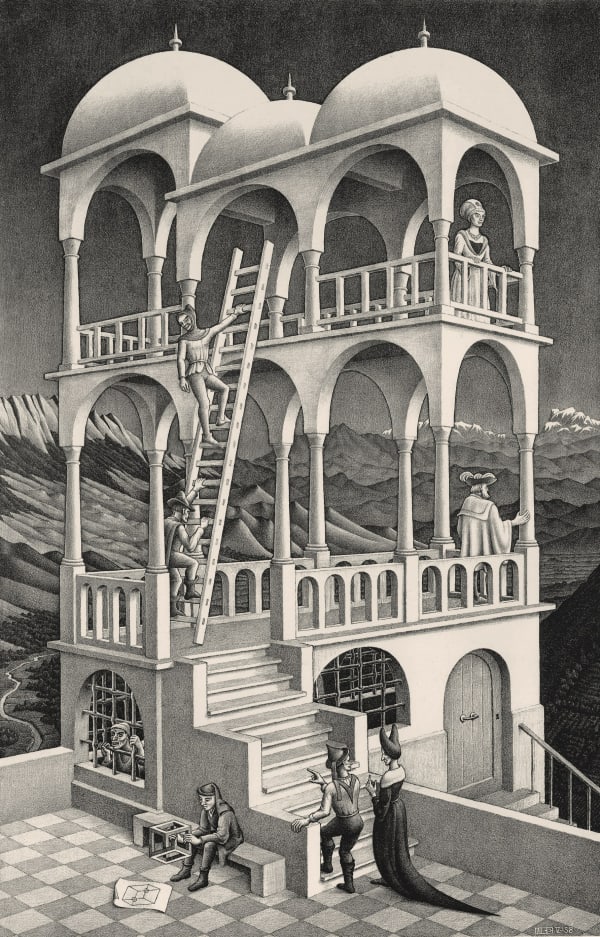Born in the Netherlands in 1898, M.C Escher (1898 - 1972) began to sketch and make prints in his early teens and eventually studied at the Haarlem School for Architecture and Decorative Arts. In 1921, Escher visited Spain where he was exposed to native Moorish tiles decorated with tessellated, interlocking, repetitive patterns which would prove to have a significant influence on the development of his artistic vision. Escher soon moved to Italy where he spent years creating drawings and prints that played with light and contrasting elements, depicting monochromatic landscapes, natural forms, and intricate architectural studies. These works laid the foundation for his future explorations into perspective.
In 1929, Escher's work had began to attract the attention of art critics and his prints where featured in exhibitions in the Netherlands and Switzerland. It was during this time when Escher began to experiment with the concepts of metamorphosis and perspective, presenting objects that gradually evolved into something completely different. The notion of metamorphosis would be a continuous theme throughout his work, as in his iconic work, Day and Night, 1938, which would eventually become the most celebrated of all his pieces.
M.C Escher's work currently resides in the collections of major museums around the world, including the National Gallery of Art, Washington D.C. His museum exhibitions draw record crowds wherever they are held.
-
 M.C. EscherThe 2nd Day of Creation, 1925Woodcut14 x 11 in (35.6 x 27.9 cm)
M.C. EscherThe 2nd Day of Creation, 1925Woodcut14 x 11 in (35.6 x 27.9 cm) -
 M.C. EscherCattolica Di Stilo, Calabria, 1930Lithograph8 7/8 x 11 3/4 in (22.5 x 29.8 cm)
M.C. EscherCattolica Di Stilo, Calabria, 1930Lithograph8 7/8 x 11 3/4 in (22.5 x 29.8 cm) -
 M.C. EscherFiumara of Stilo, Calabria, 1930Lithograph8 7/8 x 11 3/4 in (22.5 x 29.8 cm)
M.C. EscherFiumara of Stilo, Calabria, 1930Lithograph8 7/8 x 11 3/4 in (22.5 x 29.8 cm) -
 M.C. Escher(Dilapidated House in) Atrani, 1931Lithograph12 1/8 x 8 7/8 in (30.8 x 22.5 cm)
M.C. Escher(Dilapidated House in) Atrani, 1931Lithograph12 1/8 x 8 7/8 in (30.8 x 22.5 cm) -
 M.C. EscherEmblemata, Balance, 1931Woodcut7 1/8 x 5 1/2 in (18.1 x 14 cm)
M.C. EscherEmblemata, Balance, 1931Woodcut7 1/8 x 5 1/2 in (18.1 x 14 cm) -
 M.C. EscherEmblemata, Cactus, 1931Woodcut7 1/8 x 5 1/2 in (18.1 x 14 cm)
M.C. EscherEmblemata, Cactus, 1931Woodcut7 1/8 x 5 1/2 in (18.1 x 14 cm) -
 M.C. EscherTropea, Calabria, 1931Lithograph12 3/8 x 9 1/4 in (31.4 x 23.5 cm)
M.C. EscherTropea, Calabria, 1931Lithograph12 3/8 x 9 1/4 in (31.4 x 23.5 cm) -
 M.C. EscherLion of the Fountain in the Piazza at Ravello, 1932Lithograph8 3/8 x 9 1/8 in (21.3 x 23.2 cm)
M.C. EscherLion of the Fountain in the Piazza at Ravello, 1932Lithograph8 3/8 x 9 1/8 in (21.3 x 23.2 cm) -
 M.C. EscherLava Flow, Sicily, 1933Lithograph8 3/8 x 12 3/8 in (21.3 x 31.4 cm
M.C. EscherLava Flow, Sicily, 1933Lithograph8 3/8 x 12 3/8 in (21.3 x 31.4 cm -
 M.C. EscherDay and Night, 1938Woodcut on Japan paper15 3/8 x 26 5/8 in (39.1 x 67.6 cm)
M.C. EscherDay and Night, 1938Woodcut on Japan paper15 3/8 x 26 5/8 in (39.1 x 67.6 cm) -
 M.C. EscherBookplate G.H.'s Gravesande, 1940Woodcut2 3/8 x 2 3/8 in (6 x 6 cm)
M.C. EscherBookplate G.H.'s Gravesande, 1940Woodcut2 3/8 x 2 3/8 in (6 x 6 cm) -
 M.C. EscherSanta Severina, 1941Lithograph9 1/8 x 12 1/4 in (23.2 x 31.1 cm)
M.C. EscherSanta Severina, 1941Lithograph9 1/8 x 12 1/4 in (23.2 x 31.1 cm) -
 M.C. EscherEncounter, 1944Lithograph13 1/2 x 18 1/4 in (34.3 x 46.4 cm)
M.C. EscherEncounter, 1944Lithograph13 1/2 x 18 1/4 in (34.3 x 46.4 cm) -
 M.C. EscherThree Spheres, 1945Wood engraving11 x 6 3/8 in (27.9 x 16.2 cm)
M.C. EscherThree Spheres, 1945Wood engraving11 x 6 3/8 in (27.9 x 16.2 cm) -
 M.C. EscherAnother World, 1947Woodcut12 x 10 in (30.5 x 25.4 cm)
M.C. EscherAnother World, 1947Woodcut12 x 10 in (30.5 x 25.4 cm) -
 M.C. EscherStars, 1948Wood Engraving on Japan paper12 5/8 x 10 1/4 in (32.1 x 26 cm)
M.C. EscherStars, 1948Wood Engraving on Japan paper12 5/8 x 10 1/4 in (32.1 x 26 cm) -
 M.C. EscherHorses and Birds, 1949Wood engraving3 3/8 x 2 7/8 in (8.6 x 7.3 cm)
M.C. EscherHorses and Birds, 1949Wood engraving3 3/8 x 2 7/8 in (8.6 x 7.3 cm) -
 M.C. EscherOrder and Chaos (Contrast), 1950Lithograph11 x 11 in (27.9 x 27.9 cm)
M.C. EscherOrder and Chaos (Contrast), 1950Lithograph11 x 11 in (27.9 x 27.9 cm) -
 M.C. EscherRippled surface, 1950Linoleum cut and woodcut10 1/4 x 12 5/8 in (26 x 32.1 cm)
M.C. EscherRippled surface, 1950Linoleum cut and woodcut10 1/4 x 12 5/8 in (26 x 32.1 cm) -
 M.C. EscherPuddle, 1952Woodcut9 1/2 x 12 1/2 in (24.1 x 31.8 cm)
M.C. EscherPuddle, 1952Woodcut9 1/2 x 12 1/2 in (24.1 x 31.8 cm) -
 M.C. EscherE is een Ezel (Donkey), 1953Wood engraving3 7/8 x 2 1/2 in (9.8 x 6.3 cm)
M.C. EscherE is een Ezel (Donkey), 1953Wood engraving3 7/8 x 2 1/2 in (9.8 x 6.3 cm) -
 M.C. EscherRegular Division of the Plane, 1953Woodcut9 1/2 x 7 1/8 in (24.1 x 18.1 cm)
M.C. EscherRegular Division of the Plane, 1953Woodcut9 1/2 x 7 1/8 in (24.1 x 18.1 cm) -
 M.C. EscherBond of union, 1956Lithograph, No 36/56 III10 x 13 3/8 in (25.4 x 34 cm)
M.C. EscherBond of union, 1956Lithograph, No 36/56 III10 x 13 3/8 in (25.4 x 34 cm) -
 M.C. EscherPrint Gallery, 1956Lithograph16 3/16 x 16 3/16 in (41 x 41 cm)
M.C. EscherPrint Gallery, 1956Lithograph16 3/16 x 16 3/16 in (41 x 41 cm) -
 M.C. EscherSwans, 1956Wood engraving7 7/8 x 12 1/2 in (20 x 31.8 cm)
M.C. EscherSwans, 1956Wood engraving7 7/8 x 12 1/2 in (20 x 31.8 cm) -
 M.C. EscherRegelmatige Vlakverdeling (Regular Division of the Plane), 1958, 19576 Woodcuts9 1/2 x 7 1/8 in (24.1 x 18.1 cm)
M.C. EscherRegelmatige Vlakverdeling (Regular Division of the Plane), 1958, 19576 Woodcuts9 1/2 x 7 1/8 in (24.1 x 18.1 cm) -
 M.C. EscherRegular Division of the Plane II, 1957Woodcut9 1/2 x 7 1/8 in (24.1 x 18.1 cm)
M.C. EscherRegular Division of the Plane II, 1957Woodcut9 1/2 x 7 1/8 in (24.1 x 18.1 cm) -
 M.C. EscherFlatworms, 1959Lithograph12 1/2 x 16 1/4 in (31.8 x 41.3 cm)
M.C. EscherFlatworms, 1959Lithograph12 1/2 x 16 1/4 in (31.8 x 41.3 cm) -
 M.C. EscherAscending and Descending, 1960Lithograph14 x 11 1/4 in (35.6 x 28.6 cm)
M.C. EscherAscending and Descending, 1960Lithograph14 x 11 1/4 in (35.6 x 28.6 cm) -
 M.C. EscherStreet in Scanno, Abruzzi, January 1930Lithograph24 5/8 x 17 in (62.5 x 43.2 cm)
M.C. EscherStreet in Scanno, Abruzzi, January 1930Lithograph24 5/8 x 17 in (62.5 x 43.2 cm)
-

Escher The Exhibition & Experience
Frederico Giudiceandrea and Sal Iaquinta, Industry City, Brooklyn, 2018Hardcover, 256 pagesRead more
Publisher: Maurits
Dimensions: 8.5 x 10.5 -
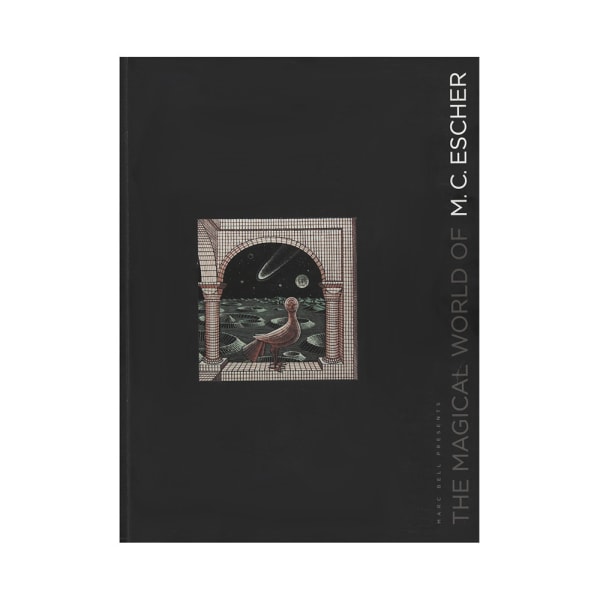
The Magical World of M. C. Escher
Marc Bell, 2009Softcover, 174 pagesRead more
Publisher: Boca Raton Museum of Art
ISBN: 0936859814
Dimensions: 9x12

